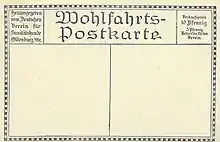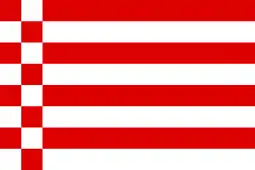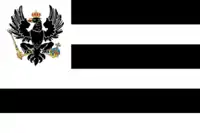Prince Leopold of Bavaria
Leopold Maximilian Joseph Maria Arnulf, Prinz von Bayern (9 February 1846 – 28 September 1930) was born in Munich, the son of Prince Regent Luitpold of Bavaria (1821–1912) and his wife Archduchess Augusta of Austria (1825–1864). He was a Field Marshal (Generalfeldmarschall) who commanded German and Austro-Hungarian forces on the Eastern Front in World War I.
| Prince Leopold | |
|---|---|
.jpg.webp) | |
| Born | 9 February 1846 Munich, Kingdom of Bavaria, German Confederation |
| Died | 28 September 1930 (aged 84) Munich, Bavaria, Weimar Republic |
| Burial | |
| Spouse | Archduchess Gisela of Austria |
| Issue | Princess Elisabeth Princess Auguste Prince Georg Prince Konrad |
| House | Wittelsbach |
| Father | Luitpold, Prince Regent of Bavaria |
| Mother | Archduchess Augusta of Austria |
| Religion | Roman Catholicism |
Biography
Military career
Prince Leopold entered the Bavarian Army at the age of 15, and received his patent as a lieutenant dated 28 November 1861.[1] He saw first combat during the Austro-Prussian War in 1866, where he commanded an artillery battery at Kissingen and Rossbrunn.
In 1870, King Ludwig II of Bavaria sent Leopold to the battlefields of France, where the Bavarian Army was fighting alongside the Prussian Army in the Franco-Prussian War. He served with the 3rd Bavarian Artillery Regiment and saw action at Sedan and Beauvert. He was promoted to major in December 1870.[2] For his bravery against the enemy he received both the Iron Cross 1st and 2nd Classes, the Bavarian Military Merit Order Knight 1st Class, the Knight's Cross of the Military Order of Max Joseph, Bavaria's highest military decoration, and decorations from several other German states.
In the post-war years, Prince Leopold spent most of his time travelling, visiting Africa, Asia and countries of Europe. In 1911 he ordered a 6m racing yacht "Ralle II" from the great British yacht designer Alfred Mylne, built at the Rambeck yard on Lake Starnberg.[3] He was married on 20 April 1873 at Vienna to his second cousin Archduchess Gisela of Austria, daughter of Emperor Franz Joseph of Austria and the Empress Elisabeth. He remained in the Bavarian army and was finally promoted to the rank of field marshal (Generalfeldmarschall) on 1 January 1905.[2] He retired from active duty in 1913.
First World War
Prince Leopold's retirement, however, did not last long. On 16 April 1915, he was given command of the German 9th Army, replacing General August von Mackensen. Leopold quickly proved himself an able commander as he took Warsaw on 4 August 1915. Following this success, he was put in command of Army Group Prince Leopold of Bavaria (Heeresgruppe Prinz Leopold von Bayern), which was a German force in the central/northern sector of the Eastern Front. He was awarded the Grand Cross of the Military Order of Max Joseph on 5 August 1915, the prestigious Pour le Mérite, Prussia's highest military decoration, on 9 August 1915 and the oak leaves to the Pour le Mérite on 25 July 1917.
On 29 August 1916, after the brutal summer campaigns succeeded in reversing the Brusilov Offensive against the Austrians, Leopold became the Supreme Commander of the German forces on the Eastern front (Oberbefehlshaber Ost), succeeding Field Marshal Paul von Hindenburg. Leopold held this post for the rest of the war. Because of his position, Leopold was a potential German candidate for the throne of the puppet Kingdom of Poland.[4]
On 4 March 1918, Leopold received yet another high honor, the Grand Cross of the Iron Cross, awarded only five times during World War I.
Prince Leopold retired again in 1918 after the signing of the Treaty of Brest-Litovsk, which had ended the war on the Eastern Front. This treaty was highly favorable to Germany, and Leopold ended his career with success. He died on 28 September 1930 in Munich and is buried in the Colombarium in the Michaelskirche in Munich.


Military ranks
- Sekondlieutenant: 28 November 1861
- Premierlieutenant: 5 June 1864
- Hauptmann: 28 April 1867
- Major: 11 December 1870
- Oberstleutnant: 27 March 1871
- Oberst: 18 February 1873
- Generalmajor: 1 November 1875
- Generalleutnant: 16 June 1881
- General der Kavallerie: 2 March 1887
- Generaloberst: 9 February 1896
- Generalfeldmarschall: 1 January 1905
Family
Prince Leopold and his wife Gisela had four children:
- Princess Elisabeth Marie of Bavaria (1874–1957), who married Otto Ludwig Philipp Graf von Seefried auf Buttenheim
- Princess Auguste Maria of Bavaria (1875–1964), who married Archduke Joseph August of Austria
- Prince Georg of Bavaria (1880–1943), married Archduchess Isabella of Austria
- Prince Konrad of Bavaria (1883–1969), who married Princess Bona Margherita of Savoy-Genoa
Greek succession
Leopold is also, according to the provisions of the Greek Constitution of 1844, the heir of the deposed King Otto of Greece. Due to the renunciation by his elder brother Ludwig of all his rights to the Greek succession and since the Greek Constitution forbade the sovereign to be ruler of another country (Ludwig became King of Bavaria), Leopold technically succeeded upon his brother's renunciation to the rights of the deposed Otto I, King of Greece. At Leopold's death his rights were inherited by his son Georg.[5]
Decorations and honors
- German decorations
.svg.png.webp) Bavaria:[6]
Bavaria:[6]
- Knight of St. Hubert
- Knight of the Military Merit Order, 2nd Class with Swords, ca. 1866; Grand Cross with Swords, 1917
- Knight of the Military Order of Max Joseph, 1871; Grand Cross, 5 August 1915[7]
- Grand Prior of Lower Bavaria of the Royal Bavarian House Equestrian Order of St. George, 1874
- St. George Medal
- Ludwig Order, Honor Cross
- Jubilee Medal with Crown
- 1866 Army Commemorative Cross
 Anhalt: Grand Cross of Albert the Bear
Anhalt: Grand Cross of Albert the Bear.svg.png.webp) Baden:
Baden:
- Knight of the House Order of Fidelity, 1898[8]
- Grand Cross of the Order of Berthold the First
 Brunswick:
Brunswick:
.svg.png.webp)
.svg.png.webp)
.svg.png.webp) Ernestine duchies: Grand Cross of the Saxe-Ernestine House Order
Ernestine duchies: Grand Cross of the Saxe-Ernestine House Order

 Free Hanseatic Cities: Hanseatic Crosses
Free Hanseatic Cities: Hanseatic Crosses Hesse and by Rhine:[10]
Hesse and by Rhine:[10]
- Grand Cross of the Ludwig Order, 13 January 1865
- Military Merit Cross (1870/71), 17 June 1873
 Lippe-Detmold:
Lippe-Detmold:
- War Honor Cross for Heroic Deeds
- War Merit Cross
 Mecklenburg:
Mecklenburg:
- Grand Cross of the Wendish Crown, with Crown
- 1870 Military Merit Cross (Schwerin)
.svg.png.webp) Saxony:
Saxony:
- Knight of the Rue Crown
- Commander of the Military Order of St. Henry, 1st Class
.svg.png.webp) Saxe-Weimar-Eisenach: Grand Cross of the White Falcon, 1888[11]
Saxe-Weimar-Eisenach: Grand Cross of the White Falcon, 1888[11] Schaumburg-Lippe: 1870 Military Merit Medal
Schaumburg-Lippe: 1870 Military Merit Medal Württemberg: Grand Cross of the Württemberg Crown, 1890[12]
Württemberg: Grand Cross of the Württemberg Crown, 1890[12].svg.png.webp) Prussia:
Prussia:
- Knight of the Black Eagle
- Grand Cross of the Red Eagle, with Swords
- Pour le Mérite, 5 August 1915; with Oak Leaves, 25 July 1917[7]
- Iron Cross, 2nd and 1st Classes, 1870; Grand Cross, 4 March 1918[7]
- Grand Commander of the Royal House Order of Hohenzollern
- War Commemorative Medal of 1870/71
- Centenary Medal
- Officers' Long Service Cross
- Red Cross Medal, 1st class with War Decoration
 Hohenzollern: Cross of Honour of the Princely House Order of Hohenzollern, 1st Class
Hohenzollern: Cross of Honour of the Princely House Order of Hohenzollern, 1st Class
Other countries
.svg.png.webp) Austria-Hungary:
Austria-Hungary:
- Knight of the Golden Fleece, 1868[13]
- Grand Cross of St. Stephen, 1881[14]
- Grand Cross of the Military Order of Maria Theresa, 26 March 1918[15]
- Military Merit Cross, 1st Class with War Decoration
- Large Military Merit Medal ("Signum Laudis")
- Red Cross Decoration 1st Class with War Decoration
- 1898 Franz Joseph I Jubilee Medal
- 1908 Franz Joseph I Jubilee Cross in Gold
- 1908 Franz Joseph I Military Jubilee Cross
.svg.png.webp) Belgium: Grand Cordon of the Order of Leopold
Belgium: Grand Cordon of the Order of Leopold_crowned.svg.png.webp) Italy: Knight of the Annunciation, 10 September 1897[16]
Italy: Knight of the Annunciation, 10 September 1897[16] Luxembourg: Knight of the Gold Lion of Nassau
Luxembourg: Knight of the Gold Lion of Nassau.svg.png.webp) Montenegro: Grand Cross of the Order of Prince Danilo I
Montenegro: Grand Cross of the Order of Prince Danilo I.svg.png.webp) Ottoman Empire:
Ottoman Empire:
- Gold Imtiaz Medal, with Swords
- Grand Commander of the Order of Glory
- Turkish War Medal ("Gallipoli Star")
.svg.png.webp) Portugal: Grand Cross of the Tower and Sword
Portugal: Grand Cross of the Tower and Sword Romania: Grand Cross of the Star of Romania
Romania: Grand Cross of the Star of Romania.svg.png.webp) Serbia:
Serbia:
.svg.png.webp) Spain: Grand Cross of the Order of Charles III, April 1876; with Collar, 1883[18]
Spain: Grand Cross of the Order of Charles III, April 1876; with Collar, 1883[18] United Kingdom: Honorary Grand Cross of the Royal Victorian Order, 15 August 1907[19]
United Kingdom: Honorary Grand Cross of the Royal Victorian Order, 15 August 1907[19]
The orders above which were from Allied nations were awarded prior to World War I.[20]
Ancestry
| Ancestors of Prince Leopold of Bavaria |
|---|
Notes
- Bavarian War Ministry, Militär-Handbuch des Königreichs Bayern, 1914
- Bavarian War Ministry, Militär-Handbuch des Königreichs Bayern, 1914
- http://scottishboating.blogspot.co.uk/2010/10/scottish-german-detective-story.html
- Polskie Towarzystwo Historyczne (Polish Historical Society), Przegląd historyczny (Historical Review), volume 60, page 87.
- Martha Schad, Kaiserin Elisabeth und ihre Töchter(München: Langen Müller, 1998)
- Hof- und Staats-Handbuch des Königreich Bayern (1908), "Königliche Orden" pp. 7, 11, 15
- "Leopold Maximilian Joseph Maria Arnulf Prinz von Bayern K.H." the Prussian Machine. Retrieved 7 August 2020.
- Hof- und Staats-Handbuch des Großherzogtum Baden (1910), "Großherzogliche Orden" p. 40
- Braunschweig, Staat (Hg.) (1905): Hof- und Staatshandbuch des Herzogtums Braunschweig für 1905. In: Hof- und Staatshandbuch des Herzogtums Braunschweig 1905. p. 11
- Hof- und Staats-Handbuch des Großherzogtum Hessen (1879), "Großherzogliche Orden und Ehrenzeichen" pp. 11, 130
- Staatshandbuch für das Großherzogtum Sachsen / Sachsen-Weimar-Eisenach (1900), "Großherzogliche Hausorden" p. 16
- Hof- und Staats-Handbuch des Königreich Württemberg (1907), "Königliche Orden" p. 29
- Boettger, T. F. "Chevaliers de la Toisón d'Or - Knights of the Golden Fleece". La Confrérie Amicale. Archived from the original on 29 July 2018. Retrieved 25 June 2019.
- "A Szent István Rend tagjai" Archived 22 December 2010 at the Wayback Machine
- "Militär Maria-Theresien-Orden 1914-1918". www.austro-hungarian-army.co.uk. Retrieved 13 September 2020.
- Italia : Ministero dell'interno (1900). Calendario generale del Regno d'Italia. Unione tipografico-editrice. p. 54.
- Acović, Dragomir (2012). Slava i čast: Odlikovanja među Srbima, Srbi među odlikovanjima. Belgrade: Službeni Glasnik. p. 369.
- "Real y distinguida orden de Carlos III", Guóa Oficial de España (in Spanish), 1929, pp. 219, 223, retrieved 4 March 2019
- The London Gazette, issue 28058, p. 6150
- Decorations as of 1914 from the Bavarian War Ministry, Militär-Handbuch des Königreichs Bayern, 1914. World War I decorations from award rolls, Erhard Roth, Verleihungen von militärischen Orden und Ehrenzeichen des Königreichs Bayern im Ersten Weltkrieg, 1997 (ISBN 3-932543-19-X), and Ferry W. von Péter, Verleihungen nichtbayerischer Orden und Ehrenzeichen an bayerischer Militärangehörige 1914-1918, 2001 (OCLC 163144588)
Further reading
| Wikimedia Commons has media related to Prince Leopold of Bavaria. |
- Leopold Prinz von Bayern 1846-1930: aus den Lebenserinnerungen, edited by Hans-Michael Körner and Ingrid Körner. Regensburg: F. Pustet, 1983.
- Wolbe, Eugen. Generalfeldmarschall Prinz Leopold von Bayern: ein Lebensbild. Leipzig: R.F. Koehler, 1920.
External links
Prince Leopold of Bavaria Born: 9 March 1846 Died: 28 September 1930 | ||
| Titles in pretence | ||
|---|---|---|
| Preceded by Ludwig |
— TITULAR — King of Greece 1913–1930 |
Succeeded by Georg |
| Military offices | ||
| Preceded by Generalleutnant Hugo Ritter von Diehl |
Commander, 1. Königlich Bayerische Division 16 June 1881 – 3 March 1887 |
Succeeded by Generalleutnant Prince Arnulf of Bavaria |
| Preceded by General der Infanterie Karl Freiherr von Horn |
Commander, I. Königlich Bayerisches Armeekorps 3 March 1887 – 27 June 1892 |
Succeeded by Generaloberst Prince Arnulf of Bavaria |
| Preceded by Generaloberst August von Mackensen |
Commander, 9th Army 17 April 1915 – 30 July 1916 |
Succeeded by Dissolved |
| Preceded by none |
Commander, Heeresgruppe Prinz Leopold von Bayern 5 August 1915 – 30 July 1916 |
Succeeded by Remus von Woyrsch |
| Preceded by Generalfeldmarschall Paul von Hindenburg |
Oberbefehlshaber Ost 29 August 1916 – 1918 |
Succeeded by Dissolved |